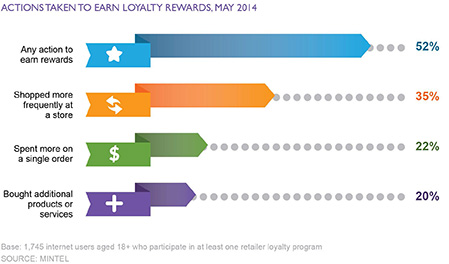Building a best-in-class loyalty program is both time consuming and carries significant upfront cost, to say the least. Retailer loyalty program participation has been on the rise since 2013, however, which indicates consumers are interested in such programs and have even come to expect them from their favorite stores. According to recent Mintel data (login required), “the number of loyalty programs consumers participate in increased from an average of 5.5 in 2013 to approximately eight programs in 2014”. Furthermore, it’s clear that loyalty programs influence behavior, given that more than half of consumers report taking some action specifically to earn loyalty rewards. The challenge that brands now face as consumer participation in loyalty initiatives becomes more popular is getting customers more actively engaged with their programs versus their competitors.

As more retailers initiate loyalty programs and customer participation increases, how does a brand keep loyalists engaged? Market data suggests traditional loyalty programs (those focused only on monetary rewards) are on the decline, meaning marketers should take a fresh look at what promotes loyalty. Consumers’ desire for seamless, compelling, and personalized brand experiences is driving the next generation of customer loyalty. While monetary rewards such as free product and store discounts tend to be foundational elements for a rewards program, other factors like customer experience, relevant offers, value for the customer, and easy redemption process are starting to become what differentiates one brand’s program from its competitors’.
Winning and retaining customer loyalty in the new era of retail requires a mix of personalization, exclusivity, and omnichannel engagement; the last of which is becoming increasingly more important as consumers hop between the store, web and mobile devices. Now more than ever, consumers want to be recognized, communicated with, and rewarded based on their personal tastes and preferences. Most importantly, they want to receive exclusive, VIP access to the products and experiences they want in exchange for their loyalty.
Leading retailers like Walgreens and Safeway experimented with distributing personalized offers and coupons through mobile apps, and Walmart has additionally focused on mobile shopping lists and features to improve the consumer’s in-store experience. CVS’s ExtraCare program rewards participants not only for purchases but also for activities such as reaching their personal health goals or refilling prescriptions on time. Sephora’s Beauty Insider program offers members points for purchases, but unlike other retailers, the points can be redeemed for a wide selection of items versus just gift cards. Once the consumer racks up enough points they can be redeemed from products that are only available to VIP members, such as limited edition sample sets of products, hand-picked sets for members, free in-store beauty classes, and additional products that aren’t available to the general public. This brand focuses heavily on the VIP consumer status and exclusivity of being an Insider.
“Winning loyal customers comes down to being relevant to the individual shopper whenever and however they choose to interact with you,” said Graeme Grant, President and COO of CQuotient. “Relevant messages build trust with the customer and keep that retailer top of mind for when the customer is ready to shop again.” Tailoring your loyalty program to what’s unique about your brand and your consumers may seem like a daunting task, but the return on your investment of time, effort, and consideration will be substantial.

 (
(